|
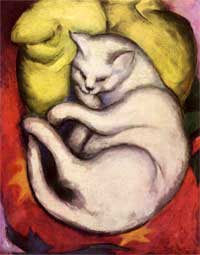 Old Friends: Although there is evidence that suggests a much older relationship, cat domestication begins in ancient Egypt. Most agree that the domesticated housecat evolved centuries ago from a catlike creature called Miacis. These animals, about the size of weasels, were early members of the carnivore order of mammals. Skilled climbers and hunters, they fed on smaller animals, and spawned, aside from cats, dogs, bears and raccoons. They went extinct about 50-63 million years ago, but not before setting the stage for the cat species. Old Friends: Although there is evidence that suggests a much older relationship, cat domestication begins in ancient Egypt. Most agree that the domesticated housecat evolved centuries ago from a catlike creature called Miacis. These animals, about the size of weasels, were early members of the carnivore order of mammals. Skilled climbers and hunters, they fed on smaller animals, and spawned, aside from cats, dogs, bears and raccoons. They went extinct about 50-63 million years ago, but not before setting the stage for the cat species.
Codependent: Of the existing species, house cats are most closely related to the African Wild Cat, and most likely evolved from their ancestors (the two species still have much in common.) Centuries ago, these highly adaptable creatures came to live on the outskirts of human civilizations, especially near Egypt, where they were always sure to find food.
Cradle of Cats: Egypt was one of the world's first great civilizations. Positioned along the great Nile River, its entire culture centered on the great river. Its people and all its great cities sat along her bank. Her waters provided fertile land, allowing the Egyptians to create a wealthy and stable civilization. All aspects of Egyptian life centered on the Nile. Its habits, generosity, and fertility determined, to a large degree, the economic, spiritual, and familial life of every Egyptian.
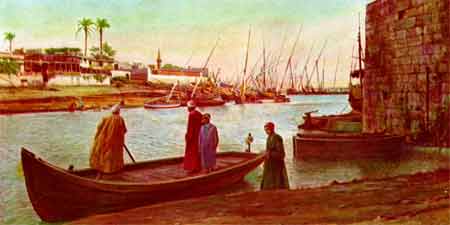
Exterminators: But life along the Nile could be quite precarious. Floods endangered food and storehouses. And also attracted disease-carrying rodents. Not only did vermin carry disease (as the people of the Middle Ages were to learn), their population could very easily get out of control, especially if left unchecked. Luckily for the Egyptians, this large rodent population attracted the African Wild Cat. These ferocious hunters patrolled the cities and storehouses of Egypt, ridding them of pests.
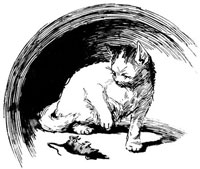 At first, the Egyptians saw these cats mainly as effective exterminators, and overlooked the threats a wild animal pose. But
eventually Egyptians began appreciating cats
on a more personal level. Food was left out for them, which brought the animals closer and closer to their homes. The cat began to recognize the humans as generous and became less aggressive. A mutualistic relationship developed– each species gained something quite valuable from the other. The cats gained food, while the humans found exterminators. Soon cats were welcome even inside the home and, because of their vital role, became important members of the community. By around 2,000 BC, the process of cat domestication, which had begun around 4,000 BC was well established. At first, the Egyptians saw these cats mainly as effective exterminators, and overlooked the threats a wild animal pose. But
eventually Egyptians began appreciating cats
on a more personal level. Food was left out for them, which brought the animals closer and closer to their homes. The cat began to recognize the humans as generous and became less aggressive. A mutualistic relationship developed– each species gained something quite valuable from the other. The cats gained food, while the humans found exterminators. Soon cats were welcome even inside the home and, because of their vital role, became important members of the community. By around 2,000 BC, the process of cat domestication, which had begun around 4,000 BC was well established.
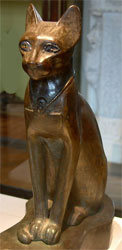 Thou shalt worship: Cats undeniably served an essential role in Egyptian life. The service they provided could, if left unattended, have a devastating effect on Egyptian life. Soon the great respect they garnered grew into outright reverence. By 1,500 BC religious cults began to grow around cats (an event the cat seemed to approve of). Cats became closely associated with the goddess Bast (or Bastet), who was represented with the body of a woman and the head of a cat. Magnificent temples sprung up throughout Egypt in honor of the goddess. Her most famous temple was established in the town of Bubastis. There, cats lived a life of luxury and cats throughout the kingdom, became sacred. Killing a cat, even if done accidentally, was punishable by death. Thou shalt worship: Cats undeniably served an essential role in Egyptian life. The service they provided could, if left unattended, have a devastating effect on Egyptian life. Soon the great respect they garnered grew into outright reverence. By 1,500 BC religious cults began to grow around cats (an event the cat seemed to approve of). Cats became closely associated with the goddess Bast (or Bastet), who was represented with the body of a woman and the head of a cat. Magnificent temples sprung up throughout Egypt in honor of the goddess. Her most famous temple was established in the town of Bubastis. There, cats lived a life of luxury and cats throughout the kingdom, became sacred. Killing a cat, even if done accidentally, was punishable by death.
World Travelers: From Egypt cats spread to the rest of the known world. Merchant ships brought them aboard to control the rodent population. They found themselves in Asia and Europe. Once they arrived their mysterious nature inspired the same devotion they had found in Egypt, especially in Asia. In the Temples of Siam, they were believed to house the souls, even kings. Here they lived a life of luxury, and were, again, treated as sacred. In Japan for instance, Emperor Ichijo once imprisoned a man whose dog had chased the Emperor’s beloved cat.
Population Drop: By the Middle Ages however, the cat’s reputation began to suffer a serious decline in Europe. Cats became associated with the devil and witchcraft. Cats were persecuted, sometimes even brought before judges and sentenced to death. Their population in Europe nearly collapsed. Simultaneously, the rodent population rose, and with it all the corresponding health problems. Plagues and disease struck Europe, sometimes wiping out huge portions of the population. Cats were slowly brought back to the continent, in an effort to control the rodents. As the rodent population was brought under control, the prejudice against cats subsided. Soon it became acceptable to own cats, and eventually even fashionable.
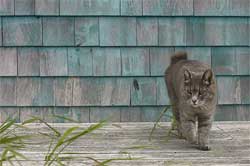 The New World: When explorers set out for the New World they The New World: When explorers set out for the New World they
had already learned the lessons of the Middle Ages and decided to take cats along. They were invited onto ships, and asked to serve in their traditional roles as rat-catchers. There are even records that cats
were brought along on the Mayflower. In the New World the cats flourished. They became essential members to almost every
household, especially on the great open plains. They lived in barns, ridding them of rats and mice. A new breed, the American Shorthair, was developed, prized for their beauty, affection, and toughness. Cat fancier clubs sprang up across the continent and Europe, with the intention of preserving the integrity of each species, as well as maintaining the health of all cats.
Today, cats are the most popular pet in the U.S., with perhaps as many as 70 million living in the United States. They outnumber dogs by 10 million, although dogs are actually present in more households. They still serve as rat-killers, but are more and more seen as pets, even members of the family.
|
